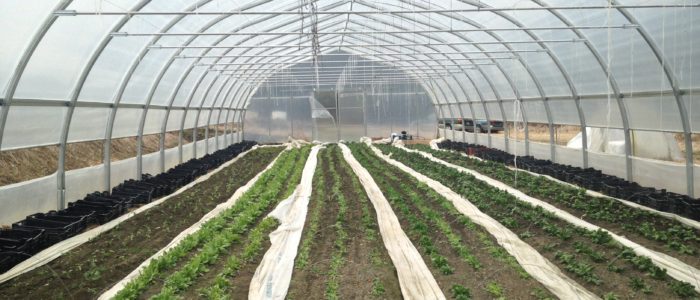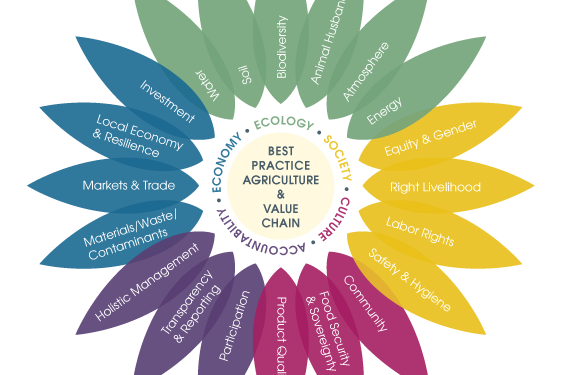Recently a colleague and friend sent me an article published in The Conversation about a forthcoming study on why consumers are suspicious of GMOs. The authors argue the problem is in the marketing, not in the product. If only the marketing was directed to how the product can personally benefit consumers, they argued, then consumers will come around and buy GMO products. I said to my friend, we cannot let this go unaddressed. In our response we question their argument by examining the broader context of GMOs from an environmental perspective in the public interest.
Darryl Benjamin
Adjunct Professor of Sustainable Food Systems and Sustainable Marketing
Green Mountain College, Poultney, Vermont
Darren R. Bardati, PhD
Department of Environment and Geography
Bishop’s University, Sherbrooke, QC Canada
____________________
Recently published “How to show consumers the benefits of genetically modified foods” by David Di Zhang and Grand Alexander Wilson points out the coming food crisis and critical food insecurity issues. The post suggests that GMOs are a solution to the problem, but the public is suspicious of their safety. The authors argue that greater public acceptance of GMOs can be achieved by fine-tuning marketing to demonstrate direct benefits to the consumer personally.
Our goal is to question their argument by examining the broader context of GMOs from an environmental perspective in the public interest.
The idea of struggling for public acceptance was well-articulated by Sir Gordon Conway, agricultural ecologist and former President of the Royal Geographical Society, UK:
“It has been argued that the industry made a major strategic mistake in leading the genetically modified organism (GMO) charge with organisms intended primarily to increase the profitability of farming systems rather than those that might, say, improve human health or help solve environmental problems such as waste-site contamination or agricultural soil degradation. Taking the profitability approach has led to public disquiet, because it is perceived that the public will bear all the potential risks of this unknown technology, while farmers in the developed world and multinational companies will enjoy all of the gains.”
The authors cite a JRSM article that states, “Plants with favourable characteristics have been produced for thousands of years by conventional breeding methods. Desirable traits are selected, combined and propagated by repeated sexual crossings over numerous generations. This is a long process, taking up to 15 years to produce new varieties. Genetic engineering not only allows this process to be dramatically accelerated in a highly targeted manner by introducing a small number of genes, it can also overcome the barrier of sexual incompatibility between plant species and vastly increase the size of the available gene pool.”
This statement is misleading, if not patently false. In fact, cross-pollinating involves two of the same variety of plant, usually carried by wind, birds or insects, resulting in plants that are very similar, but naturally varied. In contrast, genetic engineering inserts a single gene at a specific section of DNA from a different species’ genome. Combining or splicing together genes from different organisms in the lab is known as recombinant DNA technology, and the resulting organism is transgenic, or across species.
Now contrast Nature’s tens of thousands of years of plant evolution and homo sapiens slow adaptations to 30 years of human-made GMOs. Taking the reins to “improve nature” is fraught with unknowns.
GMOs are living organisms. Once released into the ecosystem, they do not degrade and cannot be recalled, but multiply in the environment and pass on their GM genes and potential mutations to future generations.
Proponents insist there are no unexpected effects; genetic engineering is a precision technique where genes are coded for a particular trait. Opponents feel differently.(1,2) They say a single change at the level of DNA can give rise to multiple changes within an organism. Further, it’s impossible to predict the impact of the GMO on its environment — the complexity of living systems is too great.
Widespread use of pesticides such as Roundup®—which is formulated to work with GMO seeds—is marketed as a “safe” herbicide, based on outdated and largely unpublished studies by manufacturers.(3)
But independent toxicological and epidemiological studies confirm that Roundup and its key ingredient glyphosate pose serious health hazards:
- Glyphosate, AMPA, and especially the commercial formulation Roundup have been found to be toxic, in some cases at extremely low levels.(4,5,6)
- Roundup caused total cell death in human cells within 24 hours at concentrations far below those used in agriculture and corresponding to levels of residues found in food and feed.(7)
- Roundup damages and kills human cells at levels below those used in agriculture (8) and at residual levels to be expected in food and feed derived from Roundup-treated crops.(9)
- Roundup is a potent endocrine disruptor (disturbs hormone function) at concentrations up to 800 times lower than the highest permitted levels in food and feed.(10) So people who eat food products from GM RR crops are eating amounts of these substances that may have toxic effects.
Irreversible mutations are also an issue, some argue. Manipulating one or two genes does not just produce one or two desired traits. Instead, just a single change at the level of the DNA can give rise to multiple changes within the organism.(11,12) It is even more impossible to predict the impact of the GMO on its environment — the complexity of living systems is too great. Unintended, uncontrolled mutations occur during the GM process and complex interactions occur at multiple levels within the organism as a result of the insertion of even a single new gene. Unintended changes could include alterations in the nutritional content of the food, toxic and allergenic effects, poor crop performance, and generation of characteristics that harm the environment. These unexpected changes are especially dangerous because they are irreversible. Even the worst chemical pollution diminishes over time as the pollutant is degraded by physical and biological mechanisms. But GMOs are living organisms. Once released into the ecosystem, they do not degrade and cannot be recalled, but multiply in the environment and pass on their GM genes to future generations.
GMO proponents argue mutations occur constantly in nature as a result of various natural exposures — to ultraviolet light, for example — so mutations caused by genetic engineering of plants are not a problem. Not true, counter the opponents; In fact, mutations occur infrequently in nature.(13) Comparing natural mutations with those that occur during the GM transformation process is like comparing apples and oranges. Every plant species has encountered natural mutagens, including certain types and levels of ionizing radiation and chemicals, throughout its natural history and has evolved mechanisms for preventing, repairing, and minimizing the impacts of mutations caused by such agents. But plants have not evolved mechanisms to repair or compensate for the insertional mutations that occur during genetic modification. Also, the high frequency of mutations caused by tissue culture during the GM process is likely to overwhelm the repair mechanisms of crop plants. Natural recombination events that move large stretches of DNA around a plant’s genome do occur. But these involve DNA sequences that are already part of the plant’s own genome, not DNA that is foreign to the species.
There is plenty of evidence that GMOs are less safe. Dr. Huber, a Professor Emeritus of Plant Pathology at Purdue University, a land grant institution, has been studying plants for 55 years.
He points out that epidemiological patterns show there’s rise in over 30 human diseases correlated directly with our increased usage of glyphosate (the active ingredient in Monsanto’s herbicide Roundup) and the increased prevalence of genetically engineered proteins in our food. Genetically engineered foods, as well as conventional crops that are heavily sprayed with glyphosate, have lower nutrient density than organic foods. They also contain high amounts of pesticides and herbicides with documented harmful health effects, along with novel, highly allergenic, proteins.
Another authoritative voice is Stephen M. Druker, author of Altered Genes, Twisted Truth: How the Venture to Genetically Engineer Our Food Has Subverted Science, Corrupted Government, and Systematically Deceived the Public. His exhaustive research into the minutiae of how GMOs were created and how they entered our food supply despite significant evidence of harmful human health effect. The book tells the story of how the genetic core of the world’s food supply came into being, how it advanced by consistently violating the protocols of science, and how for more than three decades, hundreds of eminent biologists and esteemed institutions systematically distorted the truth in order to conceal the unique risks of its products—and get them onto our dinner plates. According to David Schubert, Ph.D., molecular biologist and Head of Cellular Neurobiology at the Salk Institute for Biological Studies, “This incisive and insightful book is truly outstanding. Not only is it well-reasoned and scientifically solid, it’s a pleasure to read—and a must-read. Through its masterful marshalling of facts, it dispels the cloud of disinformation that has misled people into believing that GE foods have been adequately tested and don’t entail abnormal risk.”
Many of the public who say they don’t approve of GMOs are actually consuming them unperceived and obscured by misleading marketing and agenda-funded sources. (As Goethe said, “None are more hopelessly enslaved than those who falsely believe they are free.” In this case, free to know what is in their food.)
What alarms us about the post is ignorance of the context in which their efforts are spent. Conflicting science and a rush to the marketplace without impartial and public testing is a recipe for failure. Consider that never before in the 300,000 years of homo sapiens has food been transgenically manufactured and inserted into the food chain. Consider that it took hundreds of thousands of years of refinement of the human gut biome to gradually adjust to the environment.
The notion that we absolutely understand what we’re doing is arrogant and heavy with hubris. The idea that it’s being foisted into the marketplace with insufficient vetting is disturbing. Further, in our rush to the marketplace (some people say they’d feel GMOs were safe after a generation of testing; many say 100 years would be reasonable) to generate short-term profits, and “dramatically accelerating” the process of creating new DNA blends, effects, and species is gambling with life as we fractionally understand it, often overlooking the complex biological interactions of living orgasms. Adequate testing with objective scientific and public input — instead of 90-day rat tests by the manufacturer’s own scientists — would prove or disprove its viability and healthful characteristics.
GM foods are not properly tested for human safety before they are released for sale.(14), The only published studies that have directly tested the safety of GM foods for human consumption found potential problems but were not followed up.(15,16,17,18,19)
These studies should be followed up with controlled long-term studies and GM foods and crops should not be commercialized in the absence of such testing.
The authors go on to argue that consumers’ attitude would be “improved if GM products had a direct benefit to them personally.” The purpose of their work is to figure out how to make GMOs a sexier, more appealing product. This is a throwback to a hundred years ago when regulation was scant and snake oil salesmen promoted unhealthy blends of random substances, knowingly or unwittingly.
It is disturbing one of the authors openly admits his affiliation with Genome Canada which is a known proponent of GMOs, offering numerous funding opportunities to promote their agenda. As a marketer, the co-author’s interests focus more on how to market the product, not requiring product knowledge down to the DNA sequence.
From a public health point of view, it is irresponsible to promote and market GMOs without interdisciplinary epidemiological research and probabilistic logic recognizing causalities of nonlinear variables. For example, experimental GM rice varieties had unintended major nutritional disturbances compared with non-GM counterparts, although they were grown side-by-side in the same conditions. The structure and texture of the GM rice grain was affected, and its nutritional content and value were dramatically altered. The variation ranged from 20 to 74% for amino acids, from 19 to 38% for fatty acids, from 25 to 57% for vitamins, from 20 to 50% for nutritionally important trace elements, and 25% for protein. GM rice varieties variously showed markedly decreased levels of vitamin E, protein, and amino acids. The authors of the study(20) said that their findings “provided alarming information with regard to the nutritional value of transgenic rice” and showed that the GM rice was not substantially equivalent to non-GM.
An expanded picture is necessary. For example, how do genetic and biological factors affect one’s behavior? Could it be the public senses something that marketers and social scientists and other scientists backed by corporate interests miss? Why there is so much head-scratching as to the lack of public acceptance is puzzling given the abundance of evidence that has somehow crept through and colored consumer perception.
It may be said then that the conclusion the authors reach is shameful. Their blind, wholesale acceptance of promoting a product resisted by the public resolves into a simple formula: “In other words,” they say, “changing the value proposition from industry-centric to consumer-centric may help to mitigate the negatives associated with GM food.” Calling a thing by a different name does not change its inherent substance. They end with, “[It should be noted that] there were still a substantial portion of the participants in our study (35 per cent to 50 per cent, depending on the products presented) who refuse to purchase GM foods no matter the price. This indicates that consumer acceptance of GM foods is a complicated matter. There’s still a long road ahead to convince shoppers at the grocery stores to consider genetically modified foods as personally beneficial.”
If the public thinks it smells something rotten, then facts would go a long way to prove or disprove the viability of a product. For comparison, how many years did the public fight the tobacco industry, which knew of the dangers but sought to dismiss them, again, for marketing reasons?
Biotechnology holds great promise, but it must be presented transparently to the public before trust can be earned.
“Whether biotech foods will deliver on their promise of eliminating world hunger and bettering the lives of all remains to be seen. Their potential is enormous, yet they carry risks—and we may pay for accidents or errors in judgment in ways we cannot yet imagine. But the biggest mistake of all would be to blindly reject or endorse this new technology. If we analyze carefully how, where, and why we introduce genetically altered products, and if we test them thoroughly and judge them wisely, we can weigh their risks against their benefits to those who need them most.”
—Jennifer Ackerman, National Geographic
____________________
1 Wilson AK, Latham JR, Steinbrecher RA. Transformation-induced mutations in transgenic plants: Analysis and biosafety
implications. Biotechnol Genet Eng Rev. 2006; 23: 209-238.
2 Schubert D. A different perspective on GM food. Nat Biotechnol. Oct 2002; 20(10): 969.
3 European Commission Health & Consumer Protection Directorate-General. Review report for the active substance glyphosate. 21 January 2002.
4 Benachour N, Seralini GE. Glyphosate formulations induce apoptosis and necrosis in human umbilical, embryonic, and placental cells. Chem Res Toxicol. Jan 2009; 22: 97-105.
5 Benachour N, Sipahutar H, Moslemi S, Gasnier C, Travert C, Seralini GE. Time- and dose-dependent effects of Roundup on human embryonic and placental cells. Arch Environ ContamToxicol. Jul 2007; 53: 126-133.
6 Richard S, Moslemi S, Sipahutar H, Benachour N, Seralini GE.Differential effects of glyphosate and roundup on human placental cells and aromatase. Environ Health Perspect. Jun 2005; 113(6):716-720.
7 Benachour N, Seralini GE. Glyphosate formulations induce apoptosis and necrosis in human umbilical, embryonic, and placental cells. Chem Res Toxicol. Jan 2009; 22: 97-105.
8 Mesnage R, Clair E, Gress S, Then C, Szekacs A, Seralini G-E. Cytotoxicity on human cells of Cry1Ab and Cry1Ac Bt insecticidal toxins alone or with a glyphosate-based herbicide. Journal of Applied Toxicology. 15 Feb 2012.
9 Benachour N, Seralini GE. Glyphosate formulations induce apoptosis and necrosis in human umbilical, embryonic, and placental cells. Chem Res Toxicol. Jan 2009; 22: 97-105.
10 Gasnier C, Dumont C, Benachour N, Clair E, Chagnon MC, Seralini GE. Glyphosate-based herbicides are toxic and endocrine disruptors in human cell lines. Toxicology. Aug 21 2009; 262(3): 184-191.
11 Wilson AK, Latham JR, Steinbrecher RA. Transformation-induced mutations in transgenic plants: Analysis and biosafety implications. Biotechnol Genet Eng Rev. 2006; 23: 209-238.
12 Pusztai A, Bardocz S, Ewen SWB. Genetically modified foods: Potential human health effects. In: D’Mello JPF, ed. Food Safety: Contaminants and Toxins. Wallingford, Oxon: CABI Publishing 2003:347-372.
13 Jain SM. Mutagenesis in crop improvement under the climate change. Romanian Biotechnological Letters. 2010; 15(2): 88-106.
14 Netherwood T, Martin-Orue SM, O’Donnell AG, et al. Assessing the survival of transgenic plant DNA in the human gastrointestinal tract. Nat Biotechnol. Feb 2004; 22(2): 204-209.
15 Heritage J. The fate of transgenes in the human gut. Nat Biotechnol. Feb 2004; 22(2): 170-172.
16 Yum HY, Lee SY, Lee KE, Sohn MH, Kim KE. Genetically modified and wild soybeans: an immunologic comparison. Allergy Asthma Proc. May-Jun 2005; 26(3): 210-216.
17 Nordlee JA, Taylor SL, Townsend JA, Thomas LA, Bush RK. Identification of a Brazil-nut allergen in transgenic soybeans. NEngl J Med. Mar 14 1996; 334(11): 688-692.
18 Aris A, Leblanc S. Maternal and fetal exposure to pesticides associated to genetically modified foods in EasternTownships of Quebec, Canada. ReproductiveToxicology. 2011; 31(4).
19 Mead PS, Slutsker L, Dietz V, et al. Food-related illness and death in the United States. Emerg Infect Dis. Sep-Oct 1999; 5(5): 607-625.
20 Jiao Z, Si XX, Li GK, Zhang ZM, Xu XP. Unintended compositional changes in transgenic rice seeds (Oryza sativa L.) studied by spectral and chromatographic analysis coupled with chemometrics methods. J Agric Food Chem. Feb 10 2010; 58(3): 1746-1754.























